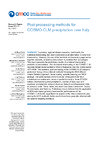To produce regional climate scenarios, traditionally, the statistical downscaling has been considered as an alternative to dynamical downscaling. However, the use of the two kinds of downscaling approaches together consents, at least to some extent, to combine their advantages.
This report presents the preliminary results of combined downscaling methods for precipitation. The dynamical downscaling is the COSMO-CLM regional climate model applied to ERA40 Reanalysis over the control period 1971-2000.
The statistical post-processing of the COSMO-CLM outputs is performed through three different methods following the MOS (Model Output Statistic) approach: linear-scaling,
quantile mapping and MOS analogs. The performances of the RCM and of the joint RCM-MOS simulations are evaluated in terms of spatial similarity of three ETCCDI indices (characterizing total precipitation, number of rainy days and maximum precipitation) between observed dataset and downscaled fields at seasonal scale.
Three Italian test cases have been considered: Orvieto, Po river basin, and Sardinia. Preliminary results indicate that the application of MOS techniques generally improves the performances of the COSMO-CLM model, regardless the season or the index considered, and, among the MOS methods, better results have been generally obtained with the quantile mapping technique.
This report represents the Deliverable P93a developed within the framework of Work Package 6.2.17 of the GEMINA project, funded by the Italian Ministry of Education, University and Research and the Italian Ministry of Environment, Land and Sea.
CMCC Institutes
CMCC Divisions


